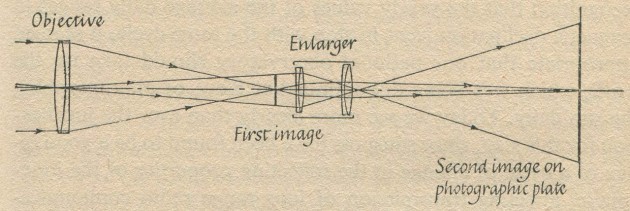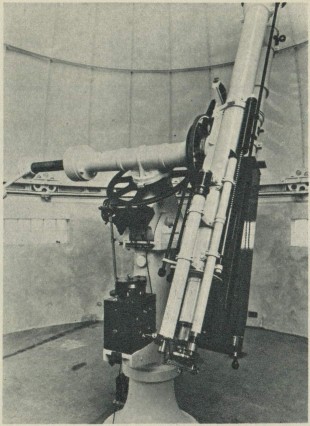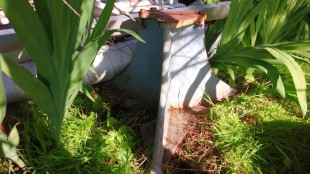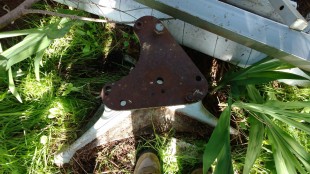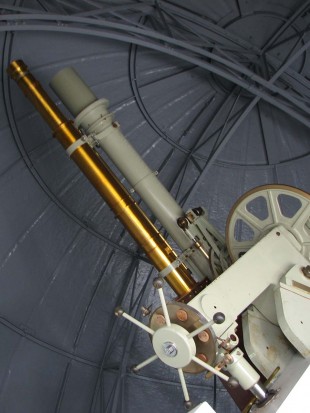…where east meets west
- Home
- Brief History
- The Greenwich Meridian
- Greenwich
(1675–1958) - Herstmonceux
(1948–1990) - Cambridge
(1990–1998) - Outstations (1822–1971)…
- – Chingford (1822–1924)
- – Deal
(1864–1927) - – Abinger
(1923–1957) - – Bristol & Bradford on Avon
(1939–1948) - – Bath
(1939–1949) - – Hartland
(1955–1967) - – Cape of Good Hope
(1959–1971)
- Administration…
- – Funding
- – Governance
- – Inventories
- – Pay
- – Regulations
- – Royal Warrants
- Contemporary Accounts
- People
- Publications
- Science
- Technology
- Telescopes
- Chronometers
- Clocks & Time
- Board of Longitude
- Libraries & Archives
- Visit
- Search
Telescope: The five Dallmeyer Photoheliographs (1873)
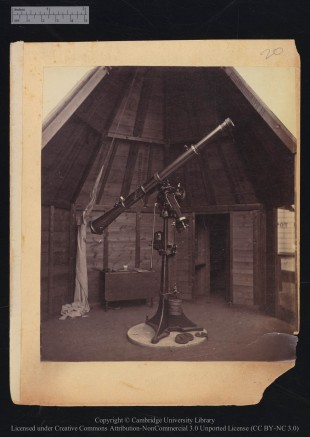
Dallmeyer Photoheliograph No. 2 undergoing testing in hut D at Greenwich in either 1873 or 1874. Reproduced under the terms of a Creative Commons Attribution-Non-Commercial (CC BY-NC) licence courtesy of Cambridge Digital Library (see below)
Prior to 1891, the five photoheliographs were identified using the letters A to E which had been used to designate the five Transit of Venus observing stations. Sometimes, the name of the Observing station was used instead. From 1891 onwards, the use of the letters A to E was dropped and the numbers 1 to 5 used instead.
At least eleven photoheliographs are known to have been made by Dallmeyer. As well as the five instruments mentioned above, Dallmeyer made at least three others of similar design which were used to observe the Transit in the colonies. One of these (originally ordered by De La Rue for his own personal use) was used to observe the Transit in India (more on this below). Two more were used in Australia. One was purchased for use in Melbourne, the other (which was supplied without a stand) was purchased for the Sydney Observatory and is now in the Powerhouse Museum. The first photoheliograph Dallmeyer ever made was ordered in 1862 for the Wilna Observatory in Russia. Completed in 1863, it remained largely unused until the late 1860s and was then destroyed by fire in 1876. His second instrument was made in 1864 for the Observatory at Harvard. A further instrument is known to have been in use by no later than 1875 at the Royal Albert Observatory in Mauritius. Of the eleven photoheliographs made by Dallmeyer, nine are known to have had a direct link to the work that was done at Greenwich.
The decision to photograph the Tranist of Venus and the ordering of the photoheliographs
The 8 December 1874 Transit of Venus was the first to occur since 1769. Initial planning for a British expedition began with the publication of a paper by Airy in 1857 (click here to read). In 1868, Airy began a correspondence with the Hydrographer of the Navy about funding an expedition. Although there had been discussion of the application of photography, photographic methods were excluded from the estimate for the expenditure of a sum of £10,500 that was put before a parliamentary committee and approved on 6 August 1869 (click here for Hansard report). Not everyone was happy at the exclusion of photographic observations, particularly the Royal Observatory’s own Board of Visitors who at their meeting on 5 June 1869 had resolved:
‘that in their opinion it would be desirable to make provision for the Photographic record of the phenomena in addition to the preparations already contemplated.’ (ADM190/4)
and as a result, at their annual meeting on 4 June 1870, the Observatory’s Board of Visitors resolved that
‘Mr warren De la Rue be requested to confer with the Astronomer Royal with the view of organizing a plan for photographic observations of the Transit of Venus, and for preparing an approximate estimate of the probable expense.’ (ADM190/4)
At their next meeting on 3 June 1871, they went further and
‘Resolved, that as this Board deem it most important that Photographic be combined with eye observations at the approaching Transit of Venus, an opinion in which the Astronomer Royal fully concurs, the Chairman [Edward Sabine] apply to the Lords Commissioners of Her Majesty’s Treasury to sanction a grant of Five Thousand Pounds (£5000) for the purpose, a sum which it is considered will cover the cost of photographic apparatus and observations for all stations.’ (ADM190/4)
Following further correspondence with Airy, the Admiralty agreed to provide the additional £5000. At this point, an order was paced with Dallmeyer for five photoheliographs, their construction being overseen by De la Rue.
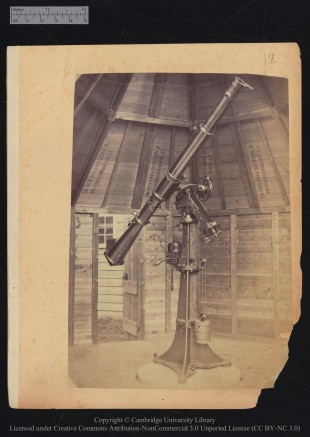
Dallmeyer Photoheliograph No. 1 undergoing testing in hut B at Greenwich in either 1873 or 1874. Reproduced under the terms of a Creative Commons Attribution-Non-Commercial (CC BY-NC) licence courtesy of Cambridge Digital Library (see below)
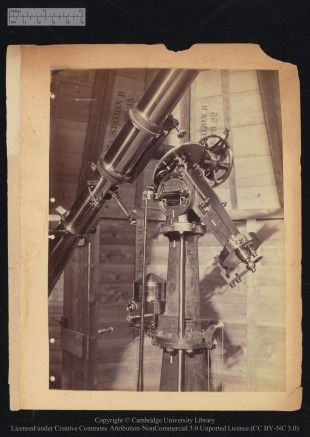
A closer view of Dallmeyer No. 1 undergoing testing at Greenwich. Note the makers plate carrying the words J H Dallmeyer, London, which can be seen at the top of the stand Reproduced under the terms of a Creative Commons Attribution-Non-Commercial (CC BY-NC) licence courtesy of Cambridge Digital Library (see below)
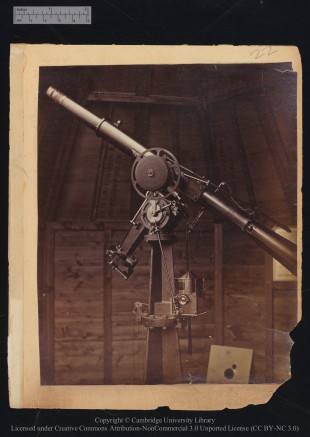
A third view of what is presumed to be Dallmeyer No.1 taken from the other side. Reproduced under the terms of a Creative Commons Attribution-Non-Commercial (CC BY-NC) licence courtesy of Cambridge Digital Library (see below)
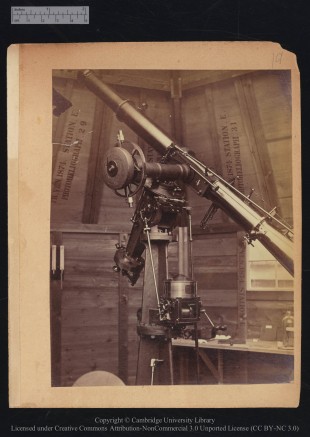
A close up of Dallmeyer No.4 undergoing testing at Greenwich in hut E. Reproduced under the terms of a Creative Commons Attribution-Non-Commercial (CC BY-NC) licence courtesy of Cambridge Digital Library (see below)
The setting up of a photographic and spectroscopic department for Greenwich
Prior to 1872, Airy had shown no interest in instigating a programme of systematic observations of the Sun at Greenwich. This would probably have remained the case if it hadn’t been for: a) others exerting pressure on the Government for more publically funded science including a dedicated astrophysical observatory, b) the crucial, but at that point unasked, question of who would take control of the Dallmeyer Photoheliographs once the Transit of Venus expedition was over, c) the presence (since 1864) of De la Rue on the Board of Visitors, and d) the imminent cessation of the solar programme at Kew.
In 1870, a Royal Commission had been set up to inquire into Scientific Instruction and the Advancement of Science. Often referred to as the Devonshire Commission, it sat from 1870–75 and produced a large number of reports.
In 1872, as the debate on the provision of a dedicated astrophysical observatory was reaching its climax, Airy made the pragmatic decision to try and fend off such an eventuality by suggesting to the Board of Visitors that the Observatory should undertake a continued series of observations of solar spots and possibly engage in solar spectroscopy as well. The Board endorsed his view at their meeting on 1 June as did the Admiralty. By the end of the year, construction of a dome to house a photoheliograph at Greenwich was under way.
Click here to read more about the photoheliographic programme and the debate of 1872.
The early years of the photoheliographic programme at Greenwich (1873–75)
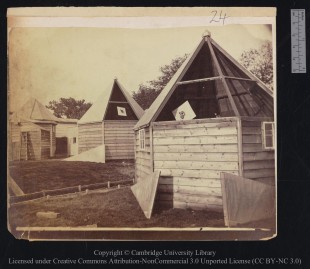
In this view, which dates from 1873 or 1874, the wooden building housing the Kew Photoheliograph is seen on the left standing on its brick foundations. To its right are huts for two of the Transit of Venus photoheliographs, the one on the right being destined for Station D (New Zealand). The viewpoint is from near the south-west corner of the Observatory site, looking across the South Ground towards the north-east. The low building behind the two huts on the left is the suite of seven Magnetic Offices. The low level fencing running from the bottom left hand corner marks the edges of a path. An engraving made from the photograph was published in The Graphic on 27 June 1874. Reproduced under the terms of a Creative Commons Attribution-Non-Commercial (CC BY-NC) licence courtesy of Cambridge Digital Library (see below)
In preparation for its arrival at Greenwich, a small wooden building with a rotary dome had been erected on the south side of the Magnetic Offices (close to the centre of where the north wing of the South Building now stands). It had a connection though to Magnetic Office No. 3, which served as a dark room. Alterations were also made to Office No.2 so that it could serve as a chemical room. Work commenced in November 1872 with the brick foundations being in place by the 18th of the month (RGO6/26) and the photoheliograph becoming operational in February 1873. A fire-proof chemical room was later erected nearby and fitted with a gas-stove for keeping the photographic chemicals at a suitable temperature throughout the winter.
Although funding was available for an extra member of staff, the new assistant, E Walter Maunder, was not appointed until later, taking up post on 6 November 1873. Meanwhile, a regular programme of recording sunspots had commenced on 1 June 1873, with photographs of the Sun being taken with either the Kew Photoheliograph and one or more of the Dallmeyers. Unfortunately, the published daily observations do not indicate which photoheliograph was used to obtain them. In preparation for the 1874 Transit, instruction on the photographic process was initially given by Reynolds who had attended the 1860 eclipse at Rivabellosa with De La Rue and the Kew Photoheliograph, and subsequently under Captain Abney (Airy autobiography).
The Kew Photoheliograph was dismounted by Dallmeyer’s staff on 22 September 1875 and replaced by the Transit of Venus Photoheliograph that had been sent to New Zealand (RGO6/784, 1876 BofV Report p.9 & ADM190/4/402). It was subsequently returned to Kew on 5 January 1876.
Airy’s 1873 description of the Dallmeyer Photoheliograph
The five Dallmeyers were initially all sent to Greenwich for testing and training purposes. Two had been delivered by 22 May 1873, with the three others expected that summer. As was his normal custom Airy wrote a description of the Dallmeyer Photoheliograph that was published in the introduction to each of the annual volumes of Greenwich Observations. The text below is transcribed from the 1873 volume which is the first volume in which it appeared.
‘The Dallmeyer Photoheliograph has an object-glass of 4 inches aperture and 5 feet focal length, forming an image of the Sun half an inch in diameter; this image is enlarged by a secondary magnifier to 4 inches on the camera screen, where the sensitive plate is inserted, the whole length of instrument being about 8 feet. The exposure is given by a shutter, having a slit of adjustable width, which is carried by a spring across the primary image. At the principal focus cross-wires are placed, which give facilities for determining the position-angles of spots on the photographs. The instrument is equatoreally mounted, though this is not absolutely necessary to its efficient action, as the exposure is practically instantaneous, amounting only to a few thousandths of a second in ordinary cases.’
The Dallmeyer Object Glasses
The Dallmeyers were unusual in that the flint element of the doublet was on the outside. This is stated in both the 1888 Report to the Board of Visitors (p.10) and in the description of the Melbourne Dallmeyer given by Clark and Orchiston in their 2004 paper The Melbourne Observatory Dallmeyer Photoheliograph and the 1874 transit of Venus. The OG of the Melbourne instrument is described as having an aperture of 102 mm and a focal ratio of f/15. The polar axis of the Melbourne Dallmeyer also carries the date 1869. It would be interesting to know if any parts of the three Royal Observatory Dallmeyers now owned by the National Maritime Museum have an equivalent marking.
The formal transfer of the Transit of Venus instruments to the Observatory
All five of the British Transit of Venus instruments were formally transferred to the Royal Observatory between 2 June 1877 and 16 May 1878, precise date currently unknown (ADM190/4/401–404). Their location in May/June 1878 is recorded in both a list of additions to the Observatory property (RGO7/67) and in a re-ordered list that appears in the minutes and rough minutes of the Board of Visitors (ADM190/4/402&404 & ADM190/3/251–2). They give the locations of the photoheliographs at that time as follows:
A Lent to the Cape Observatory
B Lent to the South Kensington Museum
C Lent to Col. Tenant in India [Dehra Dun]
D In use at the Royal Observatory
E Packed away in the Great Shed at the Royal Observatory
The minutes appear to have been compiled from the list in RGO7/67 or a copy of it. The letters A–E identifying the individual photoheliographs appear to have been added to the list in RGO7/67 only after it had been written out. For the reasons set out below, it is believed that at least some of the pairing in the list above is incorrect.
The arrival of the Thompson Photoheliograph in 1891
The Thompson 9-inch Photoheliograph was created from a 9-inch Photographic Refractor gifted to the Observatory by Sir Henry Thompson in 1890. It was brought into use in 1891. From then until 1936, both the Thomson and a Dallmeyer were used at Greenwich. Initially, the Thompson appears to have been the instrument of choice, (possibly because it was the superior of the two, but possibly because of its more convenient location or as a gesture towards its donor), the Dallmeyer being used when it wasn't available. This included the period from 1892 until 1898 while the Thompson was dismounted during the construction of the New Physical Building, times when the Thompson Equatorial was out of use for repair or maintenance work and times when the Thompson was sent overseas for eclipse expeditions. The Dallmeyer became the instrument of choice in 1912 when the Thompson was sent to observe a solar eclipse in Brazil in 1912 followed by another in Russia in 1914 from which it failed to return until 1923 because of the outbreak of war. Although it was eventually remounted at Greenwich in 1924, the Thompson played second fiddle to the Dallmeyer which had been upgraded with a new OG fitted in 1911. The last Thompson photographs measured for the published observations were taken in 1936. During the period 1924–36, the Thompson tended to be used on days of good definition or during the winter months when the Sun’s disc was reddish.
Alterations to the ‘Greenwich’ Dallmeyer
The specific Dallmeyer used at Greenwich varied over the years (more on this later). The information here refers to the ‘generic’ Dallmeyer in use.
Date |
Alteration / comment |
||
| 1884, April 2 (4?) | New secondary magnifier. This increased image diameter from 4 to 8 inches and length of instrument from about 8 feet to 9 feet 7 inches. Altered in the same manner as the photoheliograph lent to India. |
||
| 1909 | New camera, increasing length of instrument to 11 feet 2 inches. At about same time, a similar camera was fitted to the ‘Cape Dallmeyer’ and the Thompson so that all three produced images of the same size as those of Dallmeyer No.4 which by then was at Kodaikanal. | ||
| 1911 | New OG by Grubb (supplied 19 July). Focal length two inches less than Dallmeyer allowing the camera to be shortened (not specified how this was done). | ||
| 1912 | New 4-inch refractor with solar diagonal eye-piece mounted in place of counterweight. This used the OG and micrometer from Airy’s Altazimuth which had been dismounted to make way for the Dallmeyer. | ||
| 1927, Jan 23 | New enlarging lens by Ross (No.110705) working at f2.4 supplied following supply of a similar lens for the Thompson which was designed to give better definition of the Sun's limb. | ||
| 1949, May 2 | Moved to Herstmonceux and mounted on the Newbegin Refractor (without the 4-inch refractor?). | ||
| 1982 | Returned to Greenwich and mounted on pier of sheepshanks telescope in Altazimuth Pavilion. |
The above table is believed to omit a trial where two substitutions were made in the same year to the enlarging lens. Further information concerning the source of this information is currently under investigation.
The succession of alterations meant that as time went on, fewer and fewer of the original Dallmeyer parts remained. By 1949, only the tube is thought to have been an original part though the OG cell and lens cap may also have been.
The ever changing location of the ‘Greenwich’ Dallmeyer
Date |
Location of Photoheliograph / comment |
||
| 1875–1891 | Hut originally built for Kew Photoheliograph in South Ground. | ||
| 1891–1894 | Mainly in Kew Photoheliograph hut, but moved in the winter months when the Sun was obscured by the New Physical Building which was then under construction. Moved to first floor of New Museum onto the stand of another Dallmeyer (in the New Physical Building) 9 September 1891, returning to hut 6 April 1892. Moved again to same location between 9 September 1892 and 7 April 1893. Moved to 28-inch Refractor in September 1893 (the first floor of new building not being available), then to roof of south wing of New Physical Building in April 1894. | ||
| 1894–1899 | Roof of south wing of New Physical Building from April 1894. Dismounted 13 Oct 1898 and placed in the upper floor of the museum. |
||
| 1900 | Mounted on 26-inch Refractor from 9 March while Thompson sent to Portugal. | ||
| 1901 | Mounted on 26-inch refractor during eclipse expedition to Sumatra. |
||
| 1902–1906 | Generally not known, probably roof of either the south or west wing of New Physical Building. Mounted on 26-inch refractor from 22 July 1905, then transferred to to its own mounting on roof of west wing on 31 July 1905. Remounted on 26-inch on 10 August remaining there until 30 September when it was again dismounted. | ||
| 1907–1911 | Roof of south wing of New Physical Building. | ||
| 1911–1949 | Old Altazimuth Dome (previously occupied by Airy's Altazimuth Telescope (see Meridian Building)). |
||
| 1949–1982 | Solar Dome at Herstmonceux (the first of the domes to be built there). | ||
| 1982–present | Altazimuth Pavilion, Greenwich. |
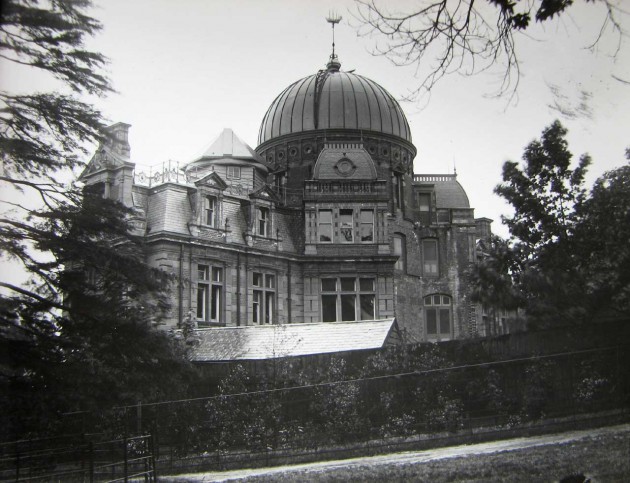
In this photo of the partially completed South Building in the summer of 1897, the hut that was placed on the roof of the south wing in April 1894 to house the photoheliograph can be seen centre left. Photograph reproduced by permission of the Greenwich Heritage Centre (see below). A copy of the photo was published in the 17 July 1897 edition of the Illustrated London News
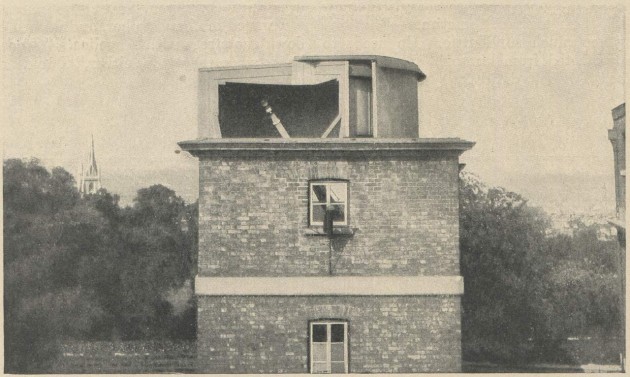
The photoheliograph soon after it had been moved into the Old Altazimuth Dome. The photo appears to have been taken during 1911 before the counter weight was replaced with a second telescope. From Sun-Storms and the Earth by E Walter Maunder. Harper's Monthly Magazine (Sept 1912)
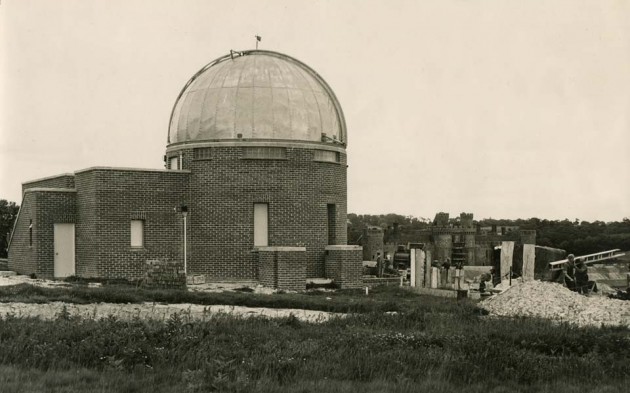
The Solar Dome at Herstmonceux in 1949. The two piers at the front of the building are on the south side and were built to support the coelostats of the Greenwich and Newbegin spectrohelioscopes which were installed the following year
Christie’s 1884 description of the ‘Greenwich’ Dallmeyer following its first modification
The first modification to the Photoheliograph took place in 1884, when a new secondary magnifier was fitted. Information about this was included by Christie in the description of the instrument that appeared in the 1884 volume of Greenwich Observations. The full description is transcribed below.
‘The Dallmeyer Photoheliograph has an object-glass of 4 inches aperture and 5 feet focal length, forming an image of the Sun half an inch in diameter; this image is enlarged by a secondary magnifier to 4 inches on the camera screen, where the sensitive plate is inserted, the whole length of instrument being about 8 feet. From 1884 April 2 a new secondary magnifier has been used by which the image is enlarged to 8 inches diameter on the camera screen, the whole length of the instrument being increased to 9 feet 7 inches. The exposure is given by a shutter, having a slit of adjustable width, which is carried by a spring across the primary image. At the principal focus cross-wires are placed, which give facilities for determining the position-angles of spots on the photographs. The instrument is equatoreally mounted, though this is not absolutely necessary to its efficient action, as the exposure is practically instantaneous, amounting only to a few thousandths of a second in ordinary cases.’
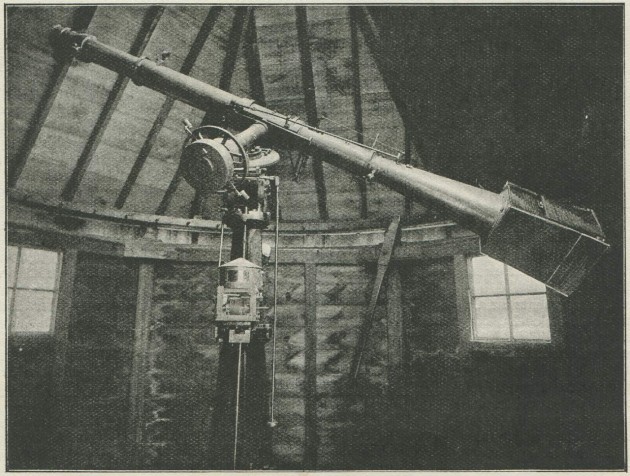
The photoheliograph showing the new secondary magnifier that was added on 2 April 1884. Photo by E Walter Maunder. From The Leisure Hour (1898) p.376
Maunder’s 1898 description of the ‘Greenwich’ Dallmeyer and its method of use
In his series of articles for The Leisure hour that were published in 1897/8 Maunder gave a brief description of the Dallmeyer Photoheliograph. This is reproduced below. The text was reused by him in largely unaltered form in his book The Royal Observatory Greenwich a glance at its history and its work which was published in 1900.
‘In order to photograph so bright a body as the sun, it is not in the least necessary to have a very large telescope. The one in common use at Greenwich is only four inches in aperture, and even that is usually diminished by a cap to three inches, and its focal length is but five feet. …
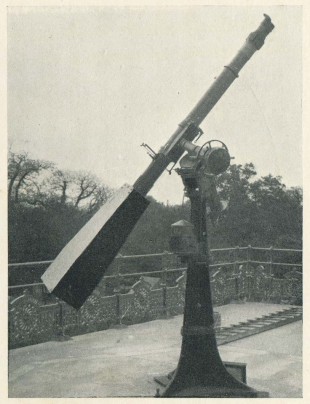
In 1909, a new enlarging lens and mahogany camera were fitted to the photoheliograph, increasing its length by 19 inches and probably making it too large for its observing hut. In this photo which was taken on the roof of the south wing of the New Physical Building soon after the camera had been fitted, the imprint left by following the hut's removal can just be made out on the roof near the base of the stand. From The heavens and their story, by Annie & E Walter Maunder
The image of the sun in the principal focus of this telescope is about six-tenths of an inch in diameter; but a magnifying lens is used, so that the photograph actually obtained is about eight inches. Even with this great enlargement, the light of the sun is so intense that with the slowest photographic plates that are made the exposure has to be for only a very small fraction of a second. This is managed by arranging a very narrow slit in a strip of brass. The strip is made to run in a groove across the principal focus. Before the exposure, it is fastened up so as to cut off all light from entering the camera part of the telescope. When all is ready, it is released and drawn down very rapidly by a powerful spring, and the slit, flying across the image of the sun, gives exposure to the plate for a very minute fraction of a second – in midsummer for less than a thousandth of a second.
Two of these photographs are taken every fine day at Greenwich; occasionally more if anything specially interesting appears to be going on.’
A problem of identity
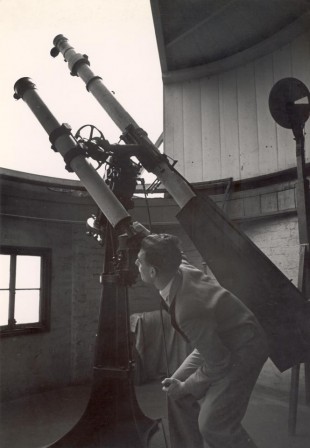
The photoheliograph during its time in the Old Altazimuth Dome. The photo was probably taken at some point after the mid 1930s. An unidentified staff member is looking though the eyepiece of the telescope incorporating the object glass of Airy's Altazimuth which was constructed and mounted in place of the counter weight in 1912
As well as the photographs mentioned above, the following sources have been used to track the identity and history of each of the instruments: The preamble to the published observations (registration (but no subscription) required), The Reports of the Astronomer Royal to the Board of Visitors, The inventories (1893 (RGO7/67), 1911 (RGO39/4), 1926 (RGO39/5) & 1933 (RGO39/6)), the minutes of the Board of Visitors (ADM190/4), the Journals of the Astronomer Royal and the First/Chief Assistants and other material identified via the archive catalogue at Cambridge.
Unfortunately, the information about the identity of the instrument that was being used at Greenwich that is given in the preamble to the published observations is not always consistent with that published in the Report of the Astronomer Royal to the Board of Visitors. This is particularly true during the 20 year period commencing in 1890 when the location of the photoheliograph had to be frequently changed during the construction of the New Physical Building (South Building). The inconsistency is likely to have been caused by the fact that much of the text of both the preamble and of the annual Report to the Visitors did not change from one year to the next and was simply copied verbatim. It seems probable, that due to an oversight that there was a failure to update certain information that had changed.
The earliest images of the photoheliographs show them at Greenwich undergoing testing in their huts prior to being shipped overseas for the Transit. Of the five photoheliographs, photographs of three of them exist from this time There are five images in total, all of which are reproduced above. They can be viewed in still higher resolution at the Cambridge Digital Library. In each of the photographs, the huts containing each of the instruments are identifiable as their component parts are marked with the station identifier (A to E) to which they were to be sent. Likewise, in four of the images the component parts of the telescope are marked with a number that has been stencilled on to them, the same number being used for all the parts of the same telescope. The relationship between letters and numbers is as follows:
| Transit of Venus Station | Designation letter |
Photoheliograph number | ||
| Egypt | A | — | ||
| Sandwich Islands | B | 1 | ||
| Rodrigues Island | C | — | ||
| New Zealand | D | 2 | ||
| Kerguelen | E | 4 |
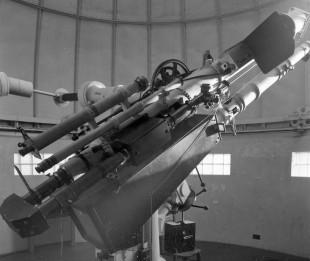
Inside the solar dome at Herstmonceux c.1955. The photoheliograph is attached to (and beneath) the Newbegin telescope (a 6�-inch refractor by Cook) which was being used with the Lyot filter
The Dallmeyer in use at Greenwich & Herstmonceux – The ‘Greenwich’ Dallmeyer
It seems fairly certain that the Dallmeyer initially in use at Greenwich was the one that had been sent to New Zealand for the Transit. This is confirmed by both its specific mention in the 1876 Report of the Astronomer Royal to the Board of Visitors (p.9) and the minutes of the Board for 1878 (ADM190/4/402).
It is also pretty certain that from 1910 onwards, the instrument in daily use was Dallmeyer No.2 . The identity of the instrument used in the period from 1878 up to 1910 is less clear as different instruments are stated as being used in different sections of the published records.
The table below has been compiled from the preamble to the published results (which only include information on the photographs selected for measurement) – specifically:
Greenwich Observations
1874-1885 Greenwich Photo-Heliographic Results
Greenwich Spectroscopic and Photographic Results (for each of the years 1878-1900
Greenwich Photo-Heliographic Results (for each of the years 1900-1955)
Bulletins
Royal Greenwich Observatory Bulletins (No. 14 (1956)
Royal Observatory Bulletins (Nos: 26 (1957), 57 (1958), 103 (1959), 132 (1960) & 144 (1961))
Annals
Royal Observatory Annals (Nos: 6 (1962–64), 8 (1965), 10 (1966), 11 (1967), 12 (1968–71) & 13 (1972–76))
Year |
Dallmeyer Used |
Comment |
|||
| 1874–1877 | New Zealand | Kew Photoheliograph until 17 Sep 1875, then NZ Dallmeyer | |||
| 1878–1880 | Not specified | ||||
| 1881–1898 | New Zealand | ||||
| 1899 | — | No Greenwich Dallmeyer photos used | |||
| 1900–1901 | New Zealand | ||||
| 1902 | — | No Greenwich Dallmeyer photos used | |||
| 1903–1916 | New Zealand | ||||
| 1917–76 | Not specified | From 1917 to 1948, the instrument is referred to as the Dallmeyer Photoheliograph. From 1949 onwards (following the move to Herstmonceux) it is referred to as the 4-inch photoheliograph |
Two notes in the archives at Cambridge (RGO7/70 (E8)) add to the picture (and confusion). The first is a memo written by Christie on 14 June 1886:
‘The T.V. Photoheliographs have a No. on the mounting, the letter of the station to which they were sent in 1874 on the dark slides and both No. & letter on camera end of tube.
Photoheliograph 4D was originally mounted at Greenwich for daily photographs.
In the spring of 1884 a new secondary magnifier (to give 8in images of Sun) was adapted to tube 3A and in March 1884 this tube 3A was mounted on the Photoheliograph mount No.4 & has been in regular use from that time.
The tube 4D is in Photographic Office No.3.’
The second is a list of the Photoheliographs at the Observatory on 22 May 1890 (which fails to mention the driving clock from an unspecified instrument (presumably No.2 or No.5) that was in use with the personal Equation Machine).
One complete, mounted in Photoheliograph hut: No.4
Two tubes complete: E.2. & A.5
One stand with clock in the Lassell Dome: No.3.
Whilst the first note links station A to Dallmeyer No.3, the second one appears to contradict it by linking it to Dallmeyer No.5!
The information in the table above is also at odds with that published in the Reports of the Astronomer Royal to the Board of Visitors. They indicate that photoheliographs No.2, No.3 and No.4 were all in use at different times between 1875 and 1910.
According to the Reports, the instrument set up originally was that from New Zealand. The instrument in use was not then mentioned by name in the Reports until May 1891, when the instrument in use is recorded as being No. 4. This is said to have remained in use (though for some of the time on the stand of No.3) until April 1894. No. 3 was mounted on the roof of the south wing of the New Physical Building in April 1894, remaining in use there until at least 1901. In the meantime, No.4 had been sent to the Observatory in Madras where it arrived in April 1895, never to return to England. Inconsistencies in the 1893 and 1894 Reports suggest that No.3 may in fact have been brought into use in September 1893 when the photoheliograph was mounted for the winter months on the 28-inch Refractor (see above). This would seem to be supported by the 1893 inventory (RGO7/67) which does not (for what ever reason) seem to mention the presence of No.3 at the Observatory, but does mention No.4 which is recorded as being complete on its stand on the ground [lower] floor of the New Physical Building and destined for Madras
After May 1901, no direct information is given about the identity of the photoheliograph until May 1910 when the working instrument is reported as being No.2 (with its new enlarging lens) on the roof of the south wing of the New Physical Building.
It is possible that No. 2 was in fact brought into use in 1904 as the Report for 1905 states that Nos. 2, 3 & 5 were at Greenwich, that the O.G. of No 5, was with Turner (and had apparently been so since 1898) and that Photoheliograph No.3 had been exchanged for a similar one at Mauritius (the Mauritius instrument having then become known as Dallmeyer No.3). The original No.3 was dispatched to Mauritius in 1904 (see below), but was in use at Greenwich from 12 September to 16 December 1903 while repairs were being carried out to the Thompson Dome preventing the Thompson Photoheliograph from being used. It is also possible that it was not No.2 that was mounted on the roof to replace Greenwich No.3, but the Dallmeyer from Mauritius as no photos are believed to have been taken with a Dallmeyer at Greenwich between 25 February 1904 and 21 July 1905.
A second Dallmeyer No.3 – The exchange of instruments with the Royal Alfred Observatory in Mauritius
For the days when the Greenwich Instruments were unable to take a solar photograph, plates from other observatories were used. From 1878 until 1909 some of these were obtained from the Royal Albert Observatory in Mauritius which had a Dallmeyer Photoheliograph similar to the ones that were in use at Greenwich.
The foundation stone of the Royal Albert Observatory was laid in by His Royal Highness Alfred Ernest Albert, Duke of Edinburgh on 30 May 1870. Primarily a meteorological station, it was up and running with Dr C. Meldrum as its Director in 1874. Although Meldrum had visited Kew Observatory in 1866 to acquire instruments it is not clear what arrangements were made at that time to acquire a photoheliograph. What is know, is that it was operational by 1875 (and possibly earlier) though it does not appear to have been used to observe the Transit of Venus.
By 1903, the Royal Albert Dallmeyer was in a poor state of repair. In August that year, its Director, Thomas Claxton, (a former Greenwich Computer) started a correspondence with the Astronomer Royal at Greenwich asking if he might loan them one so that theirs might be sent back to the makers for repair. Christie was happy to oblige, but suggested that as an alternative to a loan, time and money could be saved if the Royal Albert Dallmeyer was simply exchanged with one from Greenwich. It was agreed that the Royal Albert Dallmeyer would not be packed and dispatched until the Greenwich instrument had been received and was working so that there would not be a break in the sequence of photos taken at the Royal Albert. It was also agreed that the Colony would pay for repairs and alterations to ‘their’ photoheliograph as well as the cost of carriage of both instruments. The instrument sent from Greenwich, was Dallmeyer No.3 which underwent a number of alterations for the purpose. These were carried out at the Observatory. The instrument was packed into two cases for shipping. It is believed that neither the stands nor the drives were part of the exchange. By 28 September 1904, following a slight adaption to its mounting brackets once it had arrived at the Royal Albert, No.3 was mounted and ready for use. The Royal Albert Dallmeyer arrived at Greenwich on 17 February 1905 from which point onwards it too was referred to as Dallmeyer No.3. For further details on the specific alterations to the two photoheliographs, RGO7/42 should be consulted.
The Dallmeyer sent to the Cape
Edward Stone, the former First Assistant at Greenwich and HM Astronomer at the Cape of Good Hope spent part of 1875 in England, visiting the Observatory at Greenwich at various times between August and October (Journals of the Astronomer Royal & his Chief Assistant, RGO6/26 & RGO6/784). During that time, it was arranged that one of the Transit of Venus photoheliographs would return with him to the Cape. According to the minutes of the 1878 meeting of the Board of Visitors, the photoheliograph that was sent was Photoheliograph A – the instrument that had been used in Egypt. However, according to an entry in the Journal of the Chief Assistant (William Christie), Photoheliograph C, complete with its hut, was taken to Deptford Dockyard on 18 October 1875 for transmission to the Cape Observatory (RGO6/784). This was the instrument that had been sent to Rodrigues Island for the Transit. From 1894 onwards, the Astronomer Royal began to refer to the Cape photoheliograph as Dallmeyer No.1. Given that there is photographic evidence of hut C being at the Cape (see images below), it seems most likely that the instrument was in fact Photoheliograph C as stated by Christie in his journal rather the Photoheliograph A (as stated in the Board of Visitors minutes (and also in RGO7/67)) or Photoheliograph B as indicated by the photographs above of Dallmeyer No.1 while it was on trial at Greenwich. The first time that Airy told the Visitors that a photoheliograph (unspecified) had been loaned to the Cape was in his 1877 Report.
Writing to Airy on 10 March 1876 (RGO15/97/164), Stone told him that the instrument was brought into use for the first time at the Cape on 12 February 1876, going on to say that the hut was not fit for purpose as the converging ribs which support the shutters convenient prevented photographs being taken when the altitude of the Sun was high except with a very serious loss of time. He went on to say that the temperature of the dark room in the Cape climate made it ‘fearful to work in’. To compound his problems his third assistant had handed in his notice as the pay was so low.
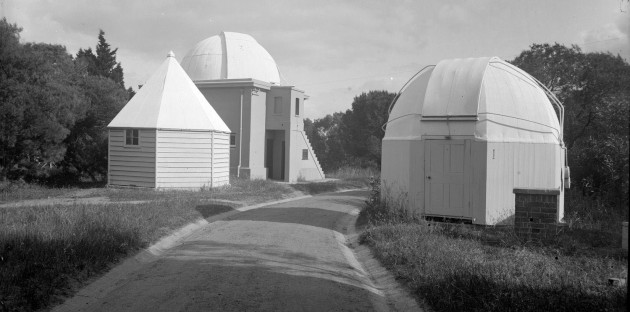
Taken at the Cape Observatory in about 1900, the photographs shows the Transit of Venus hut (left) that was originally used to house its photoheliograph. Image courtesy SAAO Archives
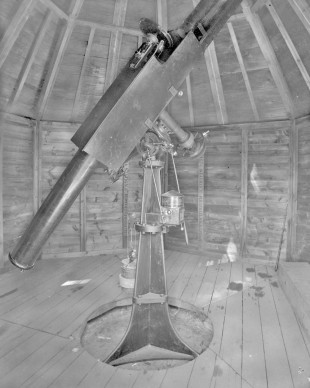
The experimental Huggins coronagraph on the Dallmeyer mount in Transit of Venus hut C at the Cape Observatory. The photo is thought to have been taken in about 1885. Image courtesy SAAO Archives
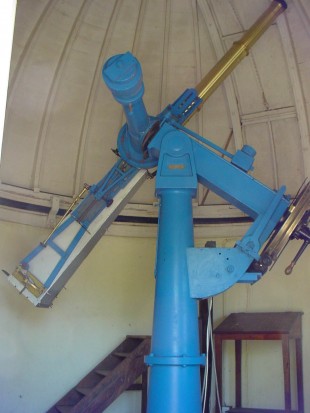
The Cape photoheliograph on the Troughton & Simms mount in 2009. The bottom section of the original Dallmeyer stand together with the original polar and declination axes were rediscovered at the Observatory in 2017. Photo courtesy of Ian Glass
In 1909, provision was made for ‘the daily photograph of the Sun in order to supplement the series of Greenwich photographs’. To this end, the photoheliograph was dismounted and forwarded to England for overhaul in March 1909. According to the 1909 Report of the Astronomer Royal to the board of Visitors, it was sent with all but 'the heavier parts of the mounting'. Christie's original intention was to send Photoheliograph No. 2 in its place rather than return No.1 to the Cape after adapting it to take photographs of the Sun on the 8-inch scale.
In the event, so we learn from the 1910 Report, it was decided to return the upgraded No. 1 to the Cape and retain the No.2 at Greenwich. We also learn, that both photoheliographs (No.1 and No.2) were fitted with identical new enlarging lenses and cameras to take photographs of the Sun on the 8-inch scale or as Christie then went on to explain, that more precisely, on a scale of one decimetre to the solar radius at mean distance. At the same time, a new camera was made for the worn out one on the Thompson photoheliograph, but at the same scale as Dallmeyer Nos. 1, 2 and 4 (which was at the Kodaikanal Observatory).
The upgraded instrument minus the middle and equatorial sections of the mounting and the driving clock arrived back at the Cape in December 1909 (the three parts above are listed in the 1911, 1926 and 1933 inventories as being at Greenwich (RGO39/4/44, RGO39/5 & RGO39/6). A suitable mounting was then made locally for attaching it to the tube of the Cape Astrographic Telescope. After a few initial experiments, it was brought into regular use on 1 March 1910.
The photoheliograph remained on the Astrographic Telescope until 1929 when it was transferred to the dome from 1849 that was originally built for a Merz 7-inch, on a Troughton & Simms mount dating from the 1870s. Pictures from the Cape were sent to Greenwich for possible inclusion in the Greenwich Photoheliographic Results from 1910 until 1976 when the Greenwich programme was brought to an end.
As a cautionary tale for future researchers, it is worth noting that in contrast to the 1911, 1926 and 1933 inventories mentioned above, and the physical evidence that still exists at the Cape, the 1910 and subsequent Reports of the Astronomer Royal list only the equatorial section of the mounting and the driving clock as being at Greenwich with the rest at the Cape. This was altered in the Reports from 1915 onwards to the ‘mechanical’ parts being at Greenwich with the remainder at the Cape. A further change to the Reports was made in 1922 when it was reported that whilst the mechanical parts were at Greenwich, only the Object Glass was at the Cape. The subsequent Reports contain the same information up until 1929 when the parts of instruments retained at Greenwich were no longer reported. As before, just the Object Glass was reported as being at the Cape. The same information was reported until the 1951 and subsequent Reports when although other equipment was still reported as being on loan to the Cape, no parts of the photoheliograph were. Although it is possible that the parts of the instrument at the Cape were permanently transferred there at this time, no evidence has been discovered to date to support this.
The Dallmeyers sent to India
On March 21, 1872, Airy wrote to Col. James Tennant in India about the possibility of setting up an observing station for the Transit of Venus in India. Later, in August, at the Brighton meeting of the British Association one of the resolutions referred to its Council for consideration and action if it seemed desirable was:
‘That the Council be requested to take such steps as they may deem desirable "to urge upon the Indian Government the preparation of a Photoheliograph and other instruments for solar observation, with the view of assisting in the observation of the Transit of Venus in 1874, and for the continuation of solar observations in India.’
Armed with this and Airy’s letter Tennant was able to persuade the Indian authorities to support the venture. By the time agreement was reached, it was too late to have a photoheliograph made by Dallmeyer. De La Rue however came to the rescue and by giving up the instrument that he had ordered for his own use from Dallmeyer. Unfortunately, the tube proved to be defective. After the transit, the photoheliograph was retained in India for use at Dehra Dun, but the other instruments acquired for the Transit were sent to England and placed in the custody of the Science and Art Department at South Kensington. In order to fix the problem with the photoheliograph, the tube of one of the British Dallmeyers at Greenwich was sent out as a replacement. This is recorded in the archives (see above) as being the tube of Dallmeyer C. Given other evidence that Dallmeyer C was in fact sent to the Cape on 18 October 1875, it would appear that the tube sent out to India was in fact that of one of the other Dallmeyers at Greenwich. The Reports of the Astronomer Royal to the Board of Visitors infer that this tube was returned to Greenwich at some point in the reporting year ending 10 May 1889.
From 1878 until 1925, photographs of the Sun taken at Dehra Dun were used to supplement those taken at Greenwich. According to the preamble in the volumes of published observations they were all taken with a Dallmeyer Photoheliograph.
In the early 1890s, Charles Michie Smith, the new Director of the Madras Observatory began investigating sites that would be better suited for the pursuit of solar physics. By 1892, it had been decided that the most appropriate location would be somewhere in the vicinity of kodaikanal some 300 miles to the south. Although the site had been secured by early 1895, it took until 1899 for the Observatory to become operational. This coincided with control of the Madras and Kodaikanal Observatories being transferred from the Madras Government to the Government of India. Amongst the Observatory’s aims was to take over the daily work of photographing the sun from the Observatory at Dehra Dun, after a five year period of overlap.
In 1895, Dallmeyer No.4, which had recently been in use at Greenwich, was dispatched to Madras for use at Kodaikanal. It came with a camera that produced images of 8 inches diameter. Although the instrument was originally sent on loan, the 1911 inventory at Greenwich records that it was permanently transferred to the Kodaikanal Observatory on 11 December 1918 (RGO39/4/46). Its present status is under investigation.
Images from Kodaikanal were used to supplement those taken at Greenwich from 1904 until 1976. Initially, images taken with the Dallmeyer were used, but from 1914 onwards they are described as having been taken with a ‘Cooke photo-visual object-glass of 6 inches aperture, the image of the Sun being on about the same 10 centimetre scale [as the other photoheliographs contributing to the record]’.
The Dallmeyer Coronograph
When taken on eclipse expeditions, the Dallmeyer Photoheliographs were converted into a coronograph. This was referred to as the Dallmeyer Coronograph. Other telescopes used as a coronograph included the Thompson Photoheliograph and the Astrographic Telescope. By way of explanation for other members of staff, the 1911 inventory contained the following note: ‘These coronographs do not exist as separate entities. They are made up as required’.
According to the inventory (RGO39/4/38) the Dallmeyer Coronograph consisted of the following parts, which were normally kept or stored in different locations:
- The object glass and tube of the Dallmeyer Photoheliograph No.3 (which by then was the replacement from Mauritius (see above))
- A 3-inches negative enlarging lens
- A mahogany camera for 12 by 10 inch photographic plates, complete with nine dark slides with hinged shutter and one with a focal plane shutter
- A Mahogany adaptor for adapting to a Simms Equatorial (unspecified)
- An adapter for the camera
- A tube
Although the 1911 inventory states that the Dallmeyer Coronograph was made up from Dallmeyer No.3, other Dallmeyers are known to have been previously used. The 1906 Report of the Astronomer Royal, states on p.27 that Maunder went to Labrador (in Canada) for the 1905 solar eclipse with the ‘Dallmeyer 4-inch coronograph , and a 4-inch rapid retilinear lens for photographs of the corona, as in Mauritius in 1901’. Although the 1905 Report gives no indication of which of the Dallmeyers was used to make up the coronograph, the 1901 Report states (p.5) that Photoheliograph No.5 was taken to Mauritius.
Loans to the South Kensington Museum
The 1874 Transit of Venus expedition caught the public imagination and was well documented and illustrated in the press. As a result, it was only natural that some of the equipment would be put on display in 1876 as part of the first special exhibition of scientific apparatus at the South Kensington Museum (the precursor of the Victoria & Albert Museum, the Science Museum and Imperial College). On Saturday 13 May 1876, Airy made a special visit to the Musuem to show Queen Victoria the instruments and photographs during a private visit to the exhibition, which ran from May to December (autobiography and journal (RGO6/26/241). In his 1877 Report, Airy told the Visitors that the following had been lent: a photoheliograph, three other telescopes (a transit, an altazimuth and an equatorial) together with their appropriate huts, chemical rooms, clocks, micrometers etc forming ‘a complete representation of a first-class establishment for observation of the Transit of Venus’.
According to the 1878 list of additions to the Observatory property (RGO7/67) and the re-ordered list that appeared in the minutes and rough minutes of the Board of Visitors (ADM190/4/402&404 & ADM190/3/251–2), the photoheliograph that was lent was photoheliograph B, the instrument that had been sent to the Sandwich Islands. Given the doubts over the accuracy of these lists in regards to the identity of the instrument sent to the Cape (see above), its accuracy with regard to the Museum needs to be regarded as dubious.
By May 1878, the Transit and Altazimuth Instruments had been returned to Greenwich but were then sent back to South Kensington the following year. Over the following years, there was a toing and froing of instruments between the Observatory the Museum and other users. Although there was no photoheliograph (or parts thereof) on loan after May 1901, other instruments were. Of particular note is the 6-inch Transit of Venus Equatorial Simms No.2 which was still recorded as being on loan to Imperial College in 1956.
Loans for the 1882 Transit of Venus expeditions
The results obtained from the 1874 Transit were disappointing, particularly in respect of the photographic images obtained with the photoheliographs. As a result, the British were reluctant to pour as much time and effort into the Transit of 1882.One consequence of this was that the Observatory at Greenwich played a much smaller pat in its organisation. It did however loan a number of instruments. According to the 1882 Report of the Astronomer Royal, this included the mountings of two of the photoheliographs which were used as substitute lighter mountings for two fo the equatorials. Lists of instruments returned from the expedition show that three stands were in fact used: one for the Corbett Equatorial (RGO 6/283/450 & 461), one for a Simms and one for a Grubb Equatorial (RGO6/283/461).
Loans for eclipse expeditions and for other purposes
Use was made of parts of the various photoheliographs in eclipse expeditions. In 1883 for example, a photoheliograph and two additional stands (for mounting 6-inch refractors on) were lent. The Object glass of No.5 was lent to Turner at Oxford for the 1898 eclipse and remained on loan with him for over 10 years when it was loaned to Newell at the newly established Solar Physics Observatory in Cambridge (established in 1912). Its presence there is recorded in all the subsequent Reports up to and including that for the year 1941. Details of other loans can be found in the various Reports.
Use of parts in the Personal Equation Machine used with the Airy Transit Circle
The Personal Equation Machine for use with the Airy Transit Circle was designed by Christie and erected in 1885. It incorporated a driving clock from one of the photoheliographs. What is not known is if it always contained the same driving clock or if others were substituted at different times. The first reference to a clock from a specific photoheliograph comes in the Astronomer Royal’s Report for 1895 when it is stated to be that from Photoheliograph No.2. This information is repeated in the subsequent Reports up to and including the year 1900, after which no further information is given. It is suspected that at this point, use of the Personal Equation Machine was discontinued and that the driving clock was removed from it.
Destruction of unused / unwanted parts
Scattered though the inventories are notes on the locations of different parts of the photoheliographs as well as the destruction of some of them. The tube, finding lens and Camera of Dallmeyer No.3 were all condemned in January 1930 (RGO39/5/27).
The instruments in the care of the National Maritime Museum at Greenwich
In 1980, the National Maritime Museum purchased for a small sum, the photoheliograph that had been used at Herstmonceux together with the Newbegin Telescope on which it was mounted. In 1982, the two telescopes were placed on the existing equatorial mounting in the Altazimuth Pavilion at Greenwich and used from time to time with the public. The dome and the instruments were not well suited, as the former was really too small for the telescope to be used without the risk of damaging it on the dome. Over the years, a number of dents appeared in the tubes which have since been removed. With the closure of the Royal Greenwich Observatory in 1998, the surviving parts of the five Transit of Venus Dallmeyers still in its possession were transferred to the National Maritime Museum. At the time of writing (2017) they have still to be properly examined. The instruments in the care of the National Maritime Museum are catalogued under the numbers: AST0967, AST0968, and AST1187.
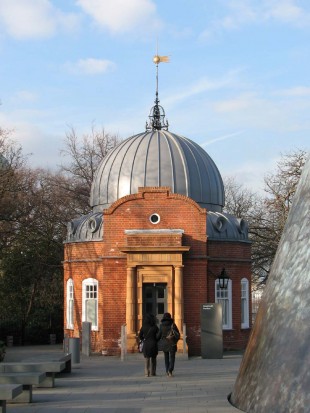
The south portico of the Altazimuth Pavilion in 2009. The building on the right is the Peter Harrison Planetarium which was opened by the Queen in May 2007
Public programmes with the Greenwich Dallmeyer
The photoheliograph at Greenwich was used with schools and the public from the time of its reinstallation at Greenwich until around 2004 when works began on the construction of the Peter Harrison Planetarium and the Altazimuth Pavilion remodelled. For this purpose, the instrument was adapted to produce an image of the Sun on a ground glass plate which was inserted in the camera in place of a photographic plate. Rather unfortunately, changes made to improve the safety of those using the telescope created several new problems that hadn’t been properly considered when the changes were planned. Firstly, it became much more difficult to access the lens caps safely and manipulate the telescope and the dome. Secondly, the reduced floor area available at the eye-end of the telescope made if difficult or impossible to observe. It was these factors together with changing priorities in the Museum that brought the regular public use of the photoheliograph at Greenwich to an end. The photoheliograph and Newbegin Refractor were dismounted and placed in storage on 6 October 2017 in order to make way for a brand new 4-inch refractor and 14-inch reflector together with a suite of accessories. It is understood that the Museum plans to use them to capture and stream images and videos of planetary, lunar, deep sky and solar targets.
Contemporary accounts and further reading
The Transit of Venus Enterprise in Victorian Britain. Jessica Ratcliffe, (Routledge, 2008)
Report on the preparations for, and observations of the transit of Venus, as seen at Roorkee and Lahore, on December 8, 1874. JF Tennant, (Calcutta, 1877)
The Greenwich Photo-heliographic Results (1874 – 1976): Summary of the Observations, Applications, Datasets, Definitions and Errors. D. M. Willis, H. E. Coffey, R. Henwood, E. H. Erwin, D. V. Hoyt, M. N. Wild & W. F. Denig. Sol Phys (2013)
The Greenwich Photo-heliographic Results (1874 – 1885): Observing Telescopes, Photographic Processes, and Solar Images. D. M. Willis, M. N. Wild, G. M. Appleby & L. T. Macdonald. Sol Phys (2016)
Re-examination of the Daily Number of Sunspot Groups for the Royal Observatory, Greenwich (1874 – 1885). D. M. Willis, M. N. Wild & J. S. Warburton. Sol Phys (2016)
Charles Michie Smith - founder of the Kodaikanal (Solar Physics) Observatory and beginnings of physical astronomy in India. N.Kameswara Rao, A.Vagiswari, Christina Birdie (2014)
Solar physics at the Kodaikanal Observatory: A Historical Perspective. S. S. Hasan, D.C.V. Mallik, S. P. Bagare, S. P. Rajaguru (2009)
Buildings and instruments of the Royal Observatory, Cape of Good Hope (from the Friends of the Observatory website)
South Kensington Museum. Handbook to the special loan collection of scientific apparatus 1876
Responding to stories: The 1876 Loan Collection of Scientific Apparatus and the Science Museum. Robert Budd (2014)
The South Kensington Museum in context: an alternative history. Bruce Robertson (2004)
Image licensing information
Special thanks are due to the Greenwich Heritage Centre for permission to reproduce the 1897 photograph of the photoheliograph hut on the roof of the partially completed South Building.
The image of the Kew Photoheliograph hut and the five images of the Dallmeyer Photoheliographs undergoing testing are reproduced in compressed form under the terms of a Creative Commons Attribution-NonCommercial 3.0 Unported License courtesy of Cambridge Digital Library (RGO6/276).
© 2014 – 2025 Graham Dolan
Except where indicated, all text and images are the copyright of Graham Dolan
